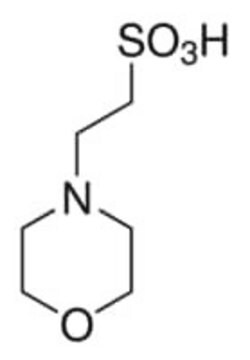M5057
MES sodium salt
BioReagent, ≥99% (titration), crystalline
Synonyme(s) :
Acide 2-(N-morpholino)éthanesulfonique sodium salt, Acide 4-morpholinoéthanesulfonique sodium salt
About This Item
Produits recommandés
Gamme de produits
BioReagent
Niveau de qualité
Pureté
≥99% (titration)
Forme
crystalline
pH
8.9-10.1 (1% in water)
Plage de pH utile
5.5-6.7
pKa
6.1
Solubilité
water: 0.5 g/mL, clear, colorless
Application(s)
diagnostic assay manufacturing
Température de stockage
room temp
Chaîne SMILES
[Na+].[O-]S(=O)(=O)CCN1CCOCC1
InChI
1S/C6H13NO4S.Na/c8-12(9,10)6-3-7-1-4-11-5-2-7;/h1-6H2,(H,8,9,10);/q;+1/p-1
Clé InChI
IRHWMYKYLWNHTL-UHFFFAOYSA-M
Vous recherchez des produits similaires ? Visite Guide de comparaison des produits
Catégories apparentées
Description générale
Application
- To achieve the required density and stretching of DNA fibers during melting of agarose plugs containing genomic DNA
- To equilibrate the Balch homogenizer chamber and to prevent sample hydrolysis before sample homogenization
Notes préparatoires
Autres remarques
Vous ne trouvez pas le bon produit ?
Essayez notre Outil de sélection de produits.
Code de la classe de stockage
13 - Non Combustible Solids
Classe de danger pour l'eau (WGK)
WGK 1
Point d'éclair (°F)
Not applicable
Point d'éclair (°C)
Not applicable
Équipement de protection individuelle
Eyeshields, Gloves, type N95 (US)
Certificats d'analyse (COA)
Recherchez un Certificats d'analyse (COA) en saisissant le numéro de lot du produit. Les numéros de lot figurent sur l'étiquette du produit après les mots "Lot" ou "Batch".
Déjà en possession de ce produit ?
Retrouvez la documentation relative aux produits que vous avez récemment achetés dans la Bibliothèque de documents.
Les clients ont également consulté
Notre équipe de scientifiques dispose d'une expérience dans tous les secteurs de la recherche, notamment en sciences de la vie, science des matériaux, synthèse chimique, chromatographie, analyse et dans de nombreux autres domaines..
Contacter notre Service technique







